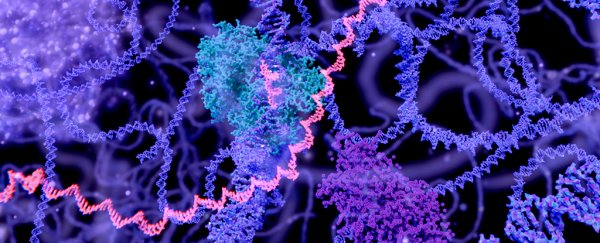The RNA World Hypothesis is a proposed explanation for how life emerged on Earth out of basic chemistry.
One long-standing paradox over the nature of life's origins is how modern biochemistry could possibly have evolved through natural selection to govern its own replication in the first place.
Today, this process is the result of a well coordinated mix of complex molecular interactions, none of which representing a living system on their own. The development of any one component in isolation raises a 'chicken and egg' conundrum.
Ribonucleic acids (RNA) are a family of organic chemical units that form complex molecules capable of both encoding information and performing physical tasks. This multitasking might have allowed them to enact life-like functions on ancient Earth that slowly evolved to incorporate more advanced forms of living chemistry.
Proposals for some kind of RNA World Hypothesis have been around for decades. In the 1960s, scientists, including Francis Crick and American biophysicist Carl Woese, have highlighted RNA's potential in performing a variety of life-supporting tasks without the direct support of DNA or proteins.
In 1986, American biochemist and Nobel Laureate Walter Gilbert coined the term RNA World to describe a hypothetical state of ancient Earth that could create such diverse forms of nucleic acids, each competing in a way that imposed natural selection to encourage increasing forms of chemical complexity.
Since then, it has become clear that certain metabolic tasks conducted by protein-based enzymes now might once have been accomplished by RNA alone.
The idea is still somewhat contentious, with evidence both supporting and challenging the hypothesis.
What evidence do we have?
So far, evidence is mostly circumstantial. RNA can encode and copy just like DNA, while also catalysing simple reactions, more or less like proteins. This could potentially have allowed self-replicating, RNA-based enzyme equivalents known as 'ribozymes' to support the physical processes needed for making imperfect copies, giving rise to molecular evolution.
In short, RNA's chemistry makes it suitable as an early stepping stone between a soup of organic chemistry and actual living cells. There are also scenarios that could allow for the generation of various nucleic acid molecules under ancient conditions.
Just how any one family of nucleic acid operated in a mixture raises challenging questions. Today some argue that original 'living' chemistry was instead a hybrid mix of DNA and RNA. Completely novel forms of nucleic acid no longer found in nature today also could have lent a hand.
Without any preserved organic material from this ancient period, finding enough evidence to support any one hypothesis is a challenge.
While there are studies that show how RNA units could have formed on the surface of ancient Earth, and others that provide possible links with other free-roaming metabolic processes, it's difficult to demonstrate which reactions necessarily occurred nearly four billion years in the past to give rise to today's insane complex biosphere.
All topic-based articles are determined by fact checkers to be correct and relevant at the time of publishing. Text and images may be altered, removed, or added to as an editorial decision to keep information current.
